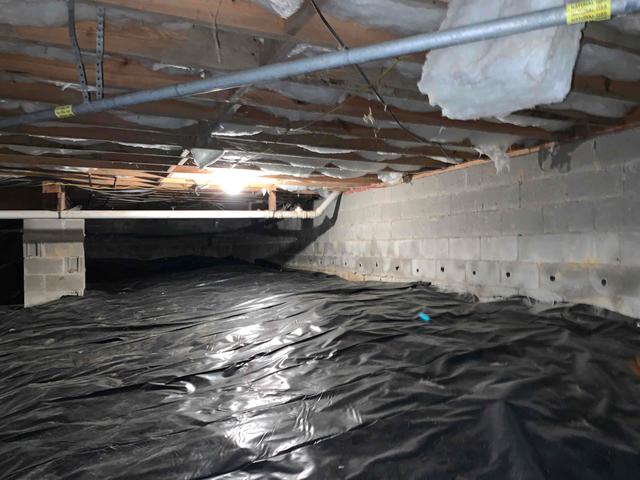
Gaps in the Existing Vapor Barrier
There were many gaps in the existing 10-mil vapor barrier of this crawl space. Without the proper sealing, the earth's moisture is able to rise into the crawl space, which can increase the relative humidity and lead to condensation or mold and mildew growth. Mold growth can occur on any organic material in the crawl space so long as the relative humidity reaches over 60% during warmer temperatures.

CleanSpace Vapor Barrier
We installed a durable 20-mil vapor barrier, called CleanSpace, over the dirt floors of this crawl space. This heavy-duty liner is wrapped around all piers, sealed with vinyl tape, and mechanically fastened to the foundation walls six to eight inches above the outside grade. CleanSpace will help protect the crawl space environment from any moisture rising from the earth and leave the crawl space looking clean and bright.

Porous Foundation Walls
The foundation walls of this crawl space were made with porous cinderblock walls, which were allowing outside water to seep through them and affect the relative humidity. Many of the walls had water marks and efflorescence on them, a clear indication of moisture infiltration.

Foamax on the Foundation Walls
We installed an R-10 value of Foamax insulation over the foundation walls of this crawl space. This will not only insulate the crawl space but will act as an air barrier and vapor retarder, giving protection to the crawl space from the outside air and moisture. It is mechanically fastened to the foundation walls, with a two-inch viewing strip left behind for termite inspectors.

Open Vents in the Foundation Walls
Many vents lined the foundation walls of the crawl space. This allows the outside air and moisture to freely flow into the crawl space. The moisture becomes trapped, affecting the relative humidity during the warmer seasons. During the winter seasons, cool air will become trapped in the crawl space, causing the floors above to become cold and uncomfortable.

Blocking off the Open Vents
We used custom foamboard pieces to internally block off the open vents lining these foundation walls. They are sealed with can foam and then covered with the Foamax insulation that covered the entire foundation wall. With these vents covered, the outside air and moisture cannot freely flow into the crawl space and affect the relative humidity and environment.


